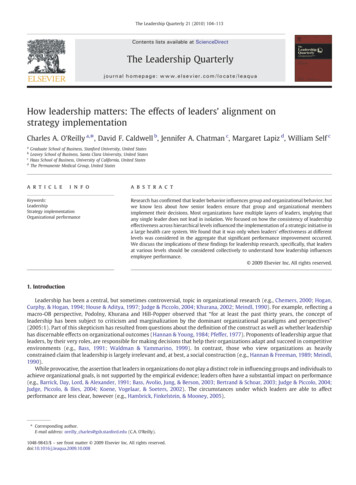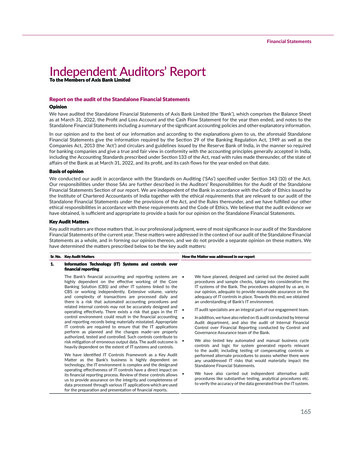
Transcription
The Leadership Quarterly 21 (2010) 104–113Contents lists available at ScienceDirectThe Leadership Quarterlyj o u r n a l h o m e p a g e : w w w. e l s e v i e r. c o m / l o c a t e / l e a q u aHow leadership matters: The effects of leaders' alignment onstrategy implementationCharles A. O'Reilly a,⁎, David F. Caldwell b, Jennifer A. Chatman c, Margaret Lapiz d, William Self cabcdGraduate School of Business, Stanford University, United StatesLeavey School of Business, Santa Clara University, United StatesHaas School of Business, University of California, United StatesThe Permanente Medical Group, United Statesa r t i c l ei n f oKeywords:LeadershipStrategy implementationOrganizational performancea b s t r a c tResearch has confirmed that leader behavior influences group and organizational behavior, butwe know less about how senior leaders ensure that group and organizational membersimplement their decisions. Most organizations have multiple layers of leaders, implying thatany single leader does not lead in isolation. We focused on how the consistency of leadershipeffectiveness across hierarchical levels influenced the implementation of a strategic initiative ina large health care system. We found that it was only when leaders' effectiveness at differentlevels was considered in the aggregate that significant performance improvement occurred.We discuss the implications of these findings for leadership research, specifically, that leadersat various levels should be considered collectively to understand how leadership influencesemployee performance. 2009 Elsevier Inc. All rights reserved.1. IntroductionLeadership has been a central, but sometimes controversial, topic in organizational research (e.g., Chemers, 2000; Hogan,Curphy, & Hogan, 1994; House & Aditya, 1997; Judge & Piccolo, 2004; Khurana, 2002; Meindl, 1990). For example, reflecting amacro-OB perspective, Podolny, Khurana and Hill-Popper observed that “for at least the past thirty years, the concept ofleadership has been subject to criticism and marginalization by the dominant organizational paradigms and perspectives”(2005:1). Part of this skepticism has resulted from questions about the definition of the construct as well as whether leadershiphas discernable effects on organizational outcomes (Hannan & Young, 1984; Pfeffer, 1977). Proponents of leadership argue thatleaders, by their very roles, are responsible for making decisions that help their organizations adapt and succeed in competitiveenvironments (e.g., Bass, 1991; Waldman & Yammarino, 1999). In contrast, those who view organizations as heavilyconstrained claim that leadership is largely irrelevant and, at best, a social construction (e.g., Hannan & Freeman, 1989; Meindl,1990).While provocative, the assertion that leaders in organizations do not play a distinct role in influencing groups and individuals toachieve organizational goals, is not supported by the empirical evidence; leaders often have a substantial impact on performance(e.g., Barrick, Day, Lord, & Alexander, 1991; Bass, Avolio, Jung, & Berson, 2003; Bertrand & Schoar, 2003; Judge & Piccolo, 2004;Judge, Piccolo, & Ilies, 2004; Koene, Vogelaar, & Soeters, 2002). The circumstances under which leaders are able to affectperformance are less clear, however (e.g., Hambrick, Finkelstein, & Mooney, 2005).⁎ Corresponding author.E-mail address: oreilly charles@gsb.stanford.edu (C.A. O'Reilly).1048-9843/ – see front matter 2009 Elsevier Inc. All rights reserved.doi:10.1016/j.leaqua.2009.10.008
C.A. O'Reilly et al. / The Leadership Quarterly 21 (2010) 104–113105One situation in which leadership effectiveness may be most visible is when an organization changes its strategy. Adoptinga new strategic initiative is distinct from implementing it (Pfeffer & Sutton, 2000), but research investigating leaders' roles insuch change often blurs the two processes. For example, studies of CEO succession that examined subsequent changes inorganizational performance associated with the appointment of a new CEO have implicitly assumed that the new CEO was ableto implement change throughout the entire organization and that leaders at lower hierarchical levels were supportive of thechange (e.g., House & Aditya, 1997; Lieberson & O'Connor, 1972; Thomas, 1988; Wasserman, Anand, & Nohria, 2001; Weiner &Mahoney, 1981). A more nuanced perspective, however, would acknowledge that for a senior leader to affect organizationalperformance requires that managers and employees at lower levels also support the new strategy (e.g., Guth & Macmillan,1986; Lee & Miller, 1999).To implement a new strategic initiative, leaders at subordinate levels must reinforce it; that is, they must allocate resources forit, deal effectively with resistance to it, and convince employees that the new initiative is important and in the employees' intereststo support (Cannella & Monroe, 1997; Rotemberg & Saloner, 1993). A number of studies have illustrated how a crucial determinantof successfully implementing a new strategic initiative is whether lower level leaders support the change (e.g., Burgelman, 1983).For example, in a study of 196 managers across 20 organizations, Wooldridge and Floyd (1990) found that the more involvedmiddle level leaders were in formulating their organization's strategy, the more the organization's performance improved as aresult of the new strategy. Guth and Macmillan (1986) reported that when middle level leaders did not support the strategy, theywere sometimes able to sabotage it. In a study of more than 200 senior leaders, Stagner (1969) reported that the degree ofconsensus among employees about the strategy was an important determinant of subsequent firm profitability. Other studies haveshown that consensus within the top leadership team about the strategy can also help or hinder its execution (Dess, 1987;Hrebiniak & Snow, 1982). This suggests that to realize performance gains from a strategic change requires that both senior andsubordinate leaders effectively communicate the strategy and take actions to ensure its implementation; that is, if subordinateleaders are not committed to the strategy, implementation is at risk.1.1. Alignment of leadersUnderstanding the effects of leadership on organizational performance requires examining multiple levels of leadershipsimultaneously (Hunter, Bedell-Avers, & Mumford, 2007). In organizations of any size it is likely that organizational performanceshould be related to the aggregate effects of leaders at different hierarchical levels. Most previous studies of leadership havefocused on the effectiveness of a single person (e.g., the CEO, a general manager, or supervisor), but leaders at differentorganizational levels are clearly important too (Hunt, 1991). For example, Berson and Avolia (2004) argue that upper-levelleaders' actions influence the ways lower level leaders translate and disseminate information about a new strategy. Themechanisms by which leaders provide meaning about critical elements in the work environment may influence this alignment. Forexample, one of the critical ways leaders influence the performance of work groups is by providing a compelling direction for thegroup (Hackman & Wageman, 2005). Similarly, Podolny, Khurana, and Hill-Popper (2005) argue that the roots of executiveleadership are in the creation of meaning within the organization. If these messages lack clarity and consistency across leaders atdifferent levels they may reduce members' ability to understand the importance of and implement strategic initiatives (Cha &Edmondson, 2006; Osborn, Hunt, & Jauch, 2002).Thus, it is clear that leaders at different levels influence strategic initiatives and their implementation, how aggregateleadership influences organizational performance is not straightforward. For instance, a powerful senior leader may compensatefor less effective leaders at lower levels. Alternatively, a less effective but highly aligned set of leaders across levels maysuccessfully implement change. Or, an effective set of subordinate managers who do not support a strategic initiative may blockchange. Regardless of the effects of an individual leader, alignment or misalignment of leaders across hierarchical levels mayenhance or detract from the successful implementation of a strategic initiative.1.2. HypothesesWe propose that leadership at one level may compensate for or undermine the effects of leadership at another. Said differently,senior leaders' ability to implement a strategic initiative may depend critically on the alignment of organizational leaders acrosshierarchical levels. This suggests two hypotheses. The first is the conventional expectation that any focal leader can affectperformance, or more formally,Hypothesis 1. The higher a department perceives that its leader (CEO, division leader, immediate or direct leader) supports a newstrategy, the stronger the likelihood that the new strategy will be implemented in that department, that is, result in increases instrategically relevant organizational performance.Our second hypothesis reflects our expectation that it is the aggregate effects of leadership across levels that matters. That is,even the strategic support demonstrated by leaders who do not personally lead a department will influence the extent to which astrategic initiative will be implemented, specifically,Hypothesis 2. The more department members perceive that leaders, aggregated across hierarchical levels support a new strategy,the stronger the likelihood that the new strategy will be implemented, that is, result in increases in strategically relevantorganizational performance in that department.
106C.A. O'Reilly et al. / The Leadership Quarterly 21 (2010) 104–1131.3. The present study1.3.1. AssumptionsPart of the ambiguity in leadership research stems from the lack of clarity in the many definitions of the construct itself (Alvesson &Sveningsson, 2003; Bedeian & Hunt, 2006). “Leadership” has been used to describe everything from the effects of first-level supervisorson subordinates' attitudes to the effects of CEOs on organizational performance (e.g., Eden & Shani, 1982; Hofmann & Jones, 2005;Thomas, 1988), from the attributional processes raters use to characterize leaders to the specific activities that leaders engage in (Lord,1985; Meindl & Ehrlich, 1987), and from the characteristics of people who emerge as leaders to the effects of actual leaders themselves(Judge, Bono, Ilies, & Gerhardt, 2002) including the ability to generate an emotional response (Dasbarough, 2006). To avoid this lack ofprecision, we define leadership as a person's ability, in a formally assigned hierarchical role, to influence a group to achieve organizationalgoals (e.g., Hogan et al., 1994; Judge et al., 2002). Specifically, we focus on ratings by subordinates of those actions taken by formallyassigned leaders at three hierarchical levels to articulate a vision for the unit, set a strategic direction, define measurable objectivesreflective of the strategy, align the reward system, motivate subordinates, and effectively deal with resistance to change. Although this isa very common way of assessing leaders, there are a number of assumptions embedded in it. First, the way we operationalize leadershipassumes that holding a management position corresponds to leadership. Second, and perhaps of more consequence, using subordinates'ratings of formal leaders assumes that subordinates actually have seen the actions taken by the leader and the items being used to assessleadership are relevant to the situation and familiar to the subordinates (Hunter et al., 2007). This is a common problem in much of theleadership research. In our case, the actions we ask subordinates to rate are likely to have been observed, however there other aspects ofleaders' behaviors that subordinates may not have directly seen that could still influence the group.1.3.2. The organization contextWe investigated the relation between leadership alignment and strategy implementation in a large health care organizationthat provides comprehensive health care to well over one million plan members. Central to the organization is a medical group ofmore than 3000 physicians who work in 19 large medical centers or clinics. The medical group is organized as a professionalcorporation with all physicians holding an equal number of shares of stock. The group is governed by a board of directors that iselected by the physician shareholders, all of whom are physicians in the group; the board, in turn, recommends a chief executiveofficer (CEO), also a physician in the group, who must be elected by the full set of physicians.Within the medical group, there are three levels of direct physician management. Physicians working in each center are organizedinto specialty groups (e.g., primary care, general surgery, etc.) that are headed by a Department Chief (him or herself a physician). TheDepartment Chiefs report to the Physician-in-Charge (PIC) of the medical center who is responsible for the overall operations of themedical center. In turn, the PICs report to the CEO of the medical group. We examined how department leaders alone and in concertwith the CEO and PIC influenced the extent to which an organizational change effort was implemented at the department level.At the time we collected data for this study, a new CEO had been elected and the organization was undergoing a substantialchange in its market strategy. The organization's previous strategy had been to use the advantages of its size to provide the samequality of care as traditional fee-for-service providers but at a lower price. Although successful in some ways, the cost of thisstrategy was that patients perceived the organization to be impersonal and bureaucratic and generally expressed a low level ofsatisfaction. With the growth of for-profit health maintenance organizations and insurance-driven preferred provider plans, thecompetitive landscape of health care had shifted and new health care organizations were able to undercut the price advantage themedical group we studied had enjoyed.Because of these changes, the CEO and board of directors concluded that they would have to change the way patients perceivedthem to successfully complete against the new set of low price providers. Therefore, the aim of the new strategy was to competenot on cost but on quality and service. The overall goal of strategic change was to significantly increase patient satisfaction, whichhad not been a central aspect of the previous low-cost approach. Thus, the measure of satisfaction is the key indicator of thesuccess of the new strategy.Successfully implementing a new strategy generally requires both tangible and intangible resources and processes (Ray,Barney, & Muhanna, 2004). In this case, the implementation occurred in two broad, somewhat overlapping phases. The first phasefocused primarily on articulating the new strategy and allocating tangible resources to support the change. For example, a newscheduling system and redesigned call centers were brought on-line across the entire organization. In the second phase, theemphasis was on changing the nature of the interactions between patients and their physicians. This represents a major leadershipchallenge for the CEO, PICs and Chiefs, since how a physician deals with her patients is difficult to monitor and standardize.Moreover, changes in patient–physician interactions would more likely result from shifts in physicians' perceptions and prioritiesthan from implementing formal control systems. Changing employees' attitudes and behaviors toward patients is therefore acritical aspect of implementing the new strategy.2. Method2.1. Respondents and study designThe participants in this study were physicians in eight specialty departments — emergency medicine, head and facial surgery,OB/GYN, ophthalmology, orthopedics, pediatrics, surgery, and urology — working in six medical centers for a total of 46departments. As described above, all physicians were members of the same medical group and all of the medical centers operated
C.A. O'Reilly et al. / The Leadership Quarterly 21 (2010) 104–113107using the same policies. The departments ranged in size from 3 to 49 physicians (x 13.37, s.d. 10.48). Within thesedepartments, 313 physicians participated in the study by completing surveys. As independent researchers we sent them surveysalong with a cover letter assuring them of the confidentiality of their responses, including pointing out that they did not need toinclude their name on the survey. Fifty-three percent of those to whom we sent the survey returned a completed survey to us.Respondents ranged in age from 30 to 69, with the largest number between the ages of 40 and 49 (34.1%). Average tenure withindepartments was 10.38 (s.d. 3.13) years. Thirty-six percent were women and 37% were members of ethnic groups other thanCaucasian. Individual respondent data were aggregated to the department level. We excluded departments with fewer than threereturned surveys, yielding a final sample of 40 medical departments comprised of 280 individual respondents.Our research design falls into the category that Klein, Dansereau and Hall (1994) characterize as a mixed determinantintervention in which a change (a new strategic initiative) is coupled with other predictors (individual leader effectiveness andaggregate leadership alignment) to influence a criterion of interest (variations in unit performance).2.2. Dependent variable: patient's ratings of access to servicePrior to the strategic change, the medical plan contracted with a national polling firm to survey a random sample of patientsregarding their overall satisfaction with their experiences with the medical plan. Patients were surveyed following a specific visit fortreatment. Questions ranged from issues such as the ease of scheduling that visit to the quality of interactions with various staffmembers, including physicians. The polling firm aggregated responses into categories, and they provided summary scale scores to themedical group's management on a quarterly basis. The firm surveyed approximately two million visits per year and aggregated theresponses by department (e.g., pediatrics, ophthalmology) within each medical center. The medical group's management provided uswith measures of the Patient Global Access Rating scale for each of the 40 departments at two points in time. This scale measurespatients' perceptions of their interactions with their physician on dimensions such as extent of listening and level of consideration aswell as perceptions of quality and accessibility of the care received. Each cross-section was based on approximately 50,000 patientsurvey evaluations. Data were provided for the period of the survey in 2003 (mean 61.54, s.d. 5.74) and equivalent data for 2001(mean 56.40, s.d. 5.97).Since we were interested in the role of leadership in capturing gains from a change in strategy, we focused on physicians'behavior change. Recall that the first phase of the change involved implementing new systems. Actions taken during this phaseprimarily affected resources and systems and were generally implemented across the entire system.The second phase was aimed more directly at changing physicians' behaviors and included extensive communication withphysicians and education programs for PICs and Chiefs. Therefore, we assessed two periods that corresponded to this second phaseof the implementation of the new strategy. The baseline satisfaction data was identified as the period after the new strategic focuson service within the organization had been communicated to the organization and the new systems necessary to support thischange had been initially installed throughout the entire organization. We asked the senior management to specify the point intime at which the benefits from the changed systems would be reflected in the patient satisfaction surveys and that furtherchanges were likely to be the result of patient interactions with physicians. The second point in time for assessing change in overallpatient satisfaction was two years later. It was at this time that we collected of the survey data. Using baseline patient satisfactionat time 1 as a predictor of patient satisfaction at time 2 permitted us to assess changes in satisfaction over the two-year period. It isduring this time frame that the change effort focused primarily on changing the behavior of individual physicians.2.3. Independent variables2.3.1. Leaders' effectiveness: leaders' support of the new strategic initiativeLeadership support for the strategy in this study refers to those actions taken by formally assigned leaders (CEO, PICs, anddepartment leaders) to implement the new strategy. With this definition, respondents were asked to indicate, on a survey wedesigned and distributed, the extent to which a set of statements applied when describing the actions of their leaders, includingseparate assessments of the organization's CEO, PIC (the leader of their medical center), and their Chief (the leader of their medicaldepartment). Respondents rated each leader on a 7-point Likert scale from “not at all” to “a great deal” on six common itemsreflecting strategic leadership. These items included assessments of the degree to which the leader articulated a strategy, set avision, provided measurable objectives, rewarded progress in the change effort, dealt with resistance, and motivated people tochange.Using factor analysis and individual level responses (N 280), we verified that respondents were able to distinguish amongthe three leadership roles. Table 1 reports the results of a Varimax rotation of the principal components solution for the 18leadership effectiveness items. Results show three well defined factors, each with an eigenvalue greater than one, whichcorrespond to the three levels of leadership: the CEO, PIC, and Chief. Based on these results we used factor loadings to compute ascale for each leader. Each scale displayed high internal consistency (the reliability coefficient ranged from .92 to .95). Wedeveloped the group level measures of leadership by averaging the individual factor scores of the physician respondents withineach department.2.3.2. Aggregating individual responsesBefore proceeding with the group level analysis we tested for the appropriateness of aggregation of the leadership and supportfor strategic change items using rwg(J) (James, Demaree, & Wolfe, 1984) on the raw item scores. All values were sufficient to
108C.A. O'Reilly et al. / The Leadership Quarterly 21 (2010) 104–113Table 1Varimax factor loadings for leadership ratings (N 280).ItemsCEO1. Clearly articulates the strategy2. Provides a compelling vision3. Provides measurable objectives for implementing the vision4. Recognizes and rewards progress in implementing change5. Responds effectively to resistance to change6. Personally inspiring and motivating for the changeCenter director1. Clearly articulates the strategy2. Provides a compelling vision3. Provides measurable objectives for implementing the vision4. Recognizes and rewards progress in implementing change5. Responds effectively to resistance to change6. Personally inspiring and motivating for the changeDepartment head1. Clearly articulates the strategy2. Provides a compelling vision3. Provides measurable objectives for implementing the vision4. Recognizes and rewards progress in implementing change5. Responds effectively to resistance to change6. Personally inspiring and motivating for the changeFactor 1Factor 2Factor 3CEO leadershipCenter leadershipDepartment 08.26.25.28.16.64.54.57.39 ify aggregation (support for the new strategy — median rwg(J) .91; CEO leadership — median rwg(J) .90; center leadership —median rwg(J) .87; and department leadership median rwg(J) .84).2.4. Control variablesWe used four control variables in models testing our hypotheses. First, since group size has been shown to affect a variety of groupoutcomes, we also included the size of each department as a control in all analyses (mean 13.37, s.d. 10.48, range 3–49). Second,since an individual's tenure may affect how he or she perceives the organizational change effort and personal willingness to change, wecomputed a mean tenure score for each department and used it as a control variable (mean 10.38 years, s.d. 3.16). Third, in orderto represent improvement in Patient Global Access Ratings between 2001 and 2003, we included the 2001 Patient Global Access Ratingscores as a control variable in all analyses (mean 56.40, s.d. 5.97).Finally, we controlled for employees' support for the strategic initiative to rule out the possibility that our results would bedriven by how much respondents supported the strategic change, rather than the influence of their leaders. Therefore,independent of the assessment of leadership effectiveness, respondents were asked to indicate how much they personallysupported the new strategic initiative. Each participating physician indicated, on a 7-point scale, from “strongly disagree” to“strongly agree,” how personally excited they were by the new strategy, the difficulties they would face if they failed to implementit, how much it was in their personal interest to adopt the strategy, and how convinced they were that the strategy was the rightone for the organization. Using the individual level data (N 280), Table 2 reports the results of a factor analysis of these itemsrevealing that the items loaded on a single factor. These items were summed to form an index of the degree to which eachindividual supported the new strategy (α .91). A group score was then computed by averaging the individual scores for eachgroup (median rwg(J) .91). The mean score indicates the overall support of group members for the new strategy. Westandardized this variable before including it as a control variable in the regression analyses used to test the hypotheses.2.5. AnalysisOur conceptual framework specifies that implementing change is a phenomenon involving multiple levels of an organization.Our dependent variable, the 2003 Patient Global Access Rating scores, was collected at the department level of the medical group.Likewise, the independent and control variables in this study were either collected at the department level or were aggregatedTable 2Factor loadings for employee support of the strategy (N 280).ItemsFactor 11.2.3.4.88.88.92.87I am personally excited about implementing our strategy.I recognize the difficulties we will face if we fail to implement this strategy.It is in my personal interest to help implement our strategy.I am personally convinced that this strategy is the right one for [our organization].
C.A. O'Reilly et al. / The Leadership Quarterly 21 (2010) 104–113109from the physician-level to the department level of analysis. Nevertheless, the departments are nested within centers, which inturn are nested within the medical group; as a result, departments within the same center are potentially more similar thandepartments from within other centers.We addressed the multilevel nature of this phenomenon statistically by using hierarchical linear modeling (HLM) (RabeHesketh & Skrondal, 2005; Raudenbush & Bryk, 2002). We used HLM to combine in a single regression equation a two-levelhierarchical linear random-intercept model, which enabled us to estimate variability between centers within the medical groupand between departments within centers. Level 1 of the model examined variability within centers, looking at how departmentsvaried in their patient satisfaction scores. Level 2 of the model examined variability between centers. The separation of betweencenter and within-center, between-department variability made possibly by using HLM controls for the effects of unobservedheterogeneity that may affect patient-satisfaction-score differences across centers. We standardized our independent variables tofacilitate interpreting our results.3. ResultsTable 3 shows the means, standard deviations, and correlations among the variables. Consistent with the strategic initiative,patient ratings between 2001 and 2003 improved from a mean of 56.40 to 61.54 (t 5.63, p b .01). Also, consistent with critics ofleadership, without controlling for various department and organizational characteristics no significant correlations between anyof the leadership effectiveness measures and patient ratings of service emerged. Importantly, there are no significant correlationsamong the effectiveness ratings for the three levels of leaders, enabling us to enter the three variables simultaneously into ourmodel testing hypothesis 2 without being concerned that multicollinearity would artificially inflate our results. There is asignificant correlation between CEO and Chief leadership effectiveness and mean physician support for the strategy. These findingssimply suggest that units with higher ratings of CEO and department leader effectiveness are also more likely to support thestrategy, not a surprising finding given the cross-sectional nature of these data. There is a marginally significant association(r .28, p b .10) between mean tenure with the organization and patient ratings in 2003, suggesting that longer service groupshave slightly higher patient satisfaction ratings. Group size is unrelated to either leadership or patient ratings of service.In hypothesis 1, we proposed that the more a department perceives that its leader supported the new strategic initiative, thehigher the likelihood that the new strategy would be implemented in that department, that is, result in increases in strategicallyrelevant organizational performance as reflected by a change in patient ratings between 2001 and 2003. In hypothesis 2, weproposed that the more department members perceive th
How leadership matters: The effects of leaders' alignment on strategy implementation Charles A. O'Reillya,⁎, David F. Caldwellb, Jennifer A. Chatmanc, Margaret Lapizd, William Selfc a Graduate School of Business, Stanford University, United States b Leavey School of Business, Santa Clara University, United States c Haas School of Business, University of California, United States










